Philips GM5653 oscilloscope
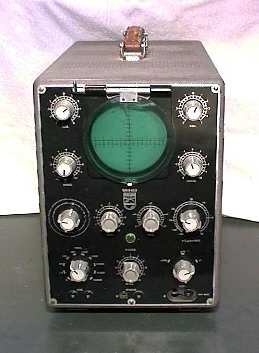

The GM5653 scope has a specified vertical 3 dB bandwidth of 3 MHz, which the manual says is sufficient for the display of TV signals. It has a free-running timebase that is synchronised with, not triggered by the input signal. The CRT has a 10 cm round screen with a usable surface of 6x8 cm. An acrylic window hinged at the top has the reading scale on it. This scope originally weighed 26 kg.
It contains 18 valves, which includes the DG10-6 CRT. Most of the valves have an 8-pin Rimlock base (pro-electron 40-series).
I didn't realise how old it was when I bought it on a flea market in Leiden in 1985. Actually I was looking for a cheap scope for hobby use. When I tried it at home, it turned out not to work properly. Brightness was too high, the spot was not blanked on fly-back and it was nearly impossible to synchronise the timebase. Above all this, the image was distorted and showed mains interference.
When I opened the enclosure, I was in for an unpleasant surprise. A previous owner had badly mistreated this piece of equipment. Part of the power supply seemed to have disappeared, as there was quite a large empty space near the power transformer. In this space some silicon rectifiers and power resistors were dangling by their leads like dead insects in a cobweb. For some reason, the mu-metal magnetic shield round the CRT had been removed, too.
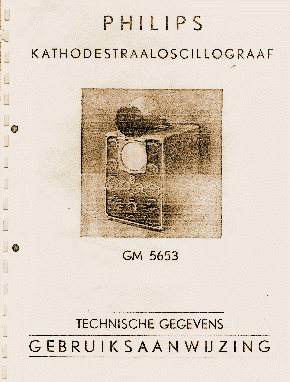
Cover photograph of the manual.
I decided to try and get the scope back in working order. As I did not have any AZ41's, I decided to use silicon rectifiers. The BYX10 rectifiers hanging around were not suitable though for the voltages in the scope HV supply, so I replaced all of them by BY127M. I added series resistors and snubbing capacitors to protect the rectifiers and mounted all on a piece of phenolic perfboard.
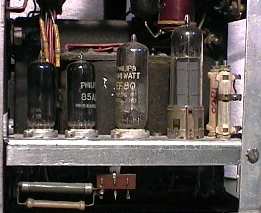
The replacement power supply subframe.
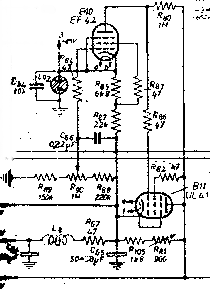
Circuit diagram of regulator.
The cause of the brightness and blanking problems lay in the capacitors that had been used to replace the coupling capacitors between the timebase and the CRT. These convey the blanking signals. They work at a high DC voltage (1400V divided over 2 capacitors) and had probably started leaking, as old paper capacitors usually do. They had been replaced by 400V types, which is asking for trouble. I replaced them by 1000 V types and after that, blanking and brightness control were OK. On the two photographs below you can see several brightly coloured capacitors that are obviously not original. Finally, I discovered that a reservoir capacitor in the HV supply had been removed. I replaced it and also replaced the parallel voltage division resistors, one of which was interrupted, probably having caused the failure of this capacitor. You can recognise the blue electrolytics on the photograph at the right. They're on the lower deck.
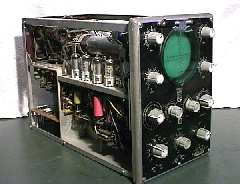
Scope is open, view at left side.
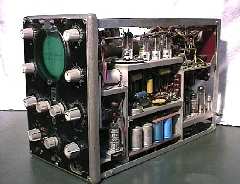
View at right side of the GM5653.
I did not use the scope much after all this work. After all, it does not have very good specifications. The timebase is impractical and bandwidth is limited. The worst thing, however, is that the mu-metal magnetic shield of the CRT has been removed by the previous owner. This affects the image stability and sharpness.
Well, it is a piece of "antique" after all. But for a historical piece of equipment too many things have been changed. I'd like to replace the knobs, if I had some original ones. Chances of finding a replacement mu-metal shield are practically zero. I might redo the restoration of the power supply and put in the right valves (EF42 and 85A1). After the restoration in 1985, I did stumble across some 85A1 reference valves on a flea-market. Unfortunately, only 2 of the stabilisers seem to be within specs, so I won't have any spares left. The voltage and internal resistance of the other ones have become too high * On the rectifier side, I still don't have enough AZ41's. I could do all this when I had too much time, but the added value would be marginal
* By the way, does anybody know what the failure mechanism behind this is? Is the neon mixed with some other gas, from outside or from evaporated material inside? OTOH, the getter is still shiny. Or maybe the neon gas has partly vanished, e.g. absorbed in metal parts?
Copyright © 2000, 2001 by Onno's E-page published 2000-08-29, last updated 2001-03-11